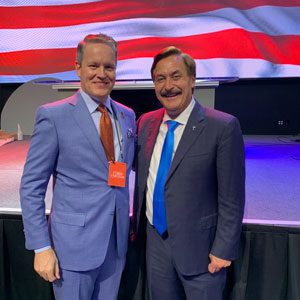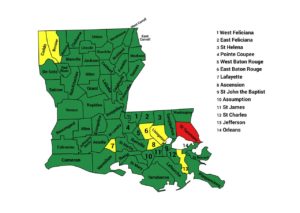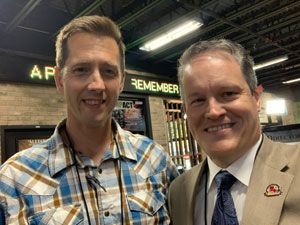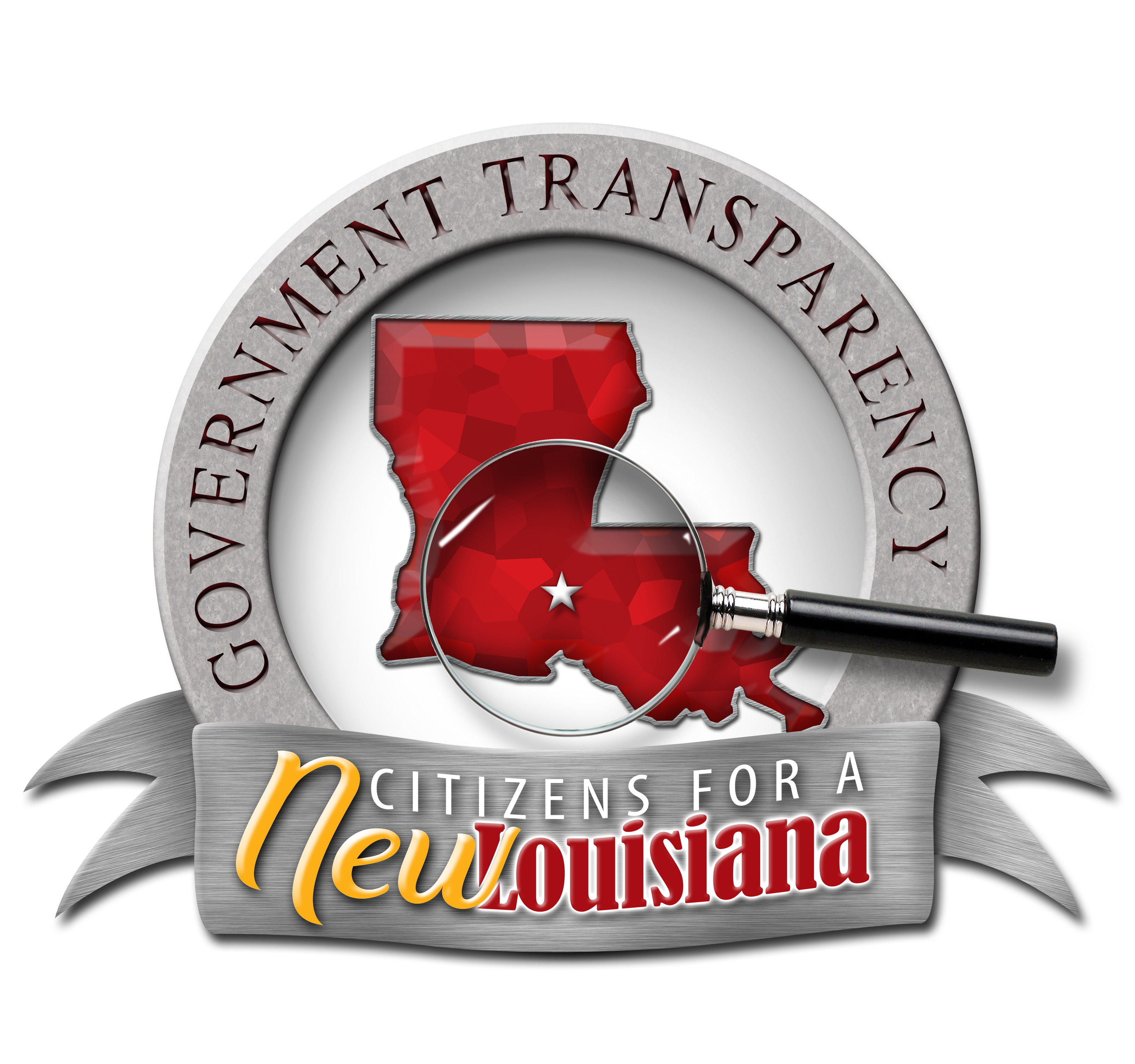 The Cyber Symposium on election integrity being put on by Mike Lindell pulled together many like-minded conservatives from around the country. Doors opened at 8:00am on Tuesday, August 10, and ended on most days around 9:00pm. The last day was Thursday, August 12th. These were long days with little room for sleep. By the last day, they claimed to have representatives from 49 states in attendance. That’s not elected representatives, mind you, but citizens who reside in those states. Still, the number of elected representatives present was striking. A rough count seems to be between forty and fifty, with a few states having several elected officials there. There were no elected representatives from Louisiana present. However, William Wallis and I were there to represent our state.
The Cyber Symposium on election integrity being put on by Mike Lindell pulled together many like-minded conservatives from around the country. Doors opened at 8:00am on Tuesday, August 10, and ended on most days around 9:00pm. The last day was Thursday, August 12th. These were long days with little room for sleep. By the last day, they claimed to have representatives from 49 states in attendance. That’s not elected representatives, mind you, but citizens who reside in those states. Still, the number of elected representatives present was striking. A rough count seems to be between forty and fifty, with a few states having several elected officials there. There were no elected representatives from Louisiana present. However, William Wallis and I were there to represent our state.
One of the stand outs from the legislative group was Virginia State Senator Amanda Chase. Throughout the event, she seemed to be that elected representative that all of the others looked to for direction. During one of the unofficial legislative side-bars, she brokered an agreement among the other elected representatives to form a multi-state election integrity caucus. The point was for representatives to avoid rumors and misinformation being propagated by the mainstream media, and instead trade facts and best practices directly with their like-minded counterparts in the various states. Time will tell, but it appears to me that this was the best thing that came out of the entire event.
Gaffs and unforced errors
Certainly, our representatives and state-wide elected officials can’t be expected to fix Arizona. Their job is to focus on challenges and solutions in Louisiana. Therefore, I saw my job as gathering and bringing back as much information as possible about Louisiana. It was during one of the legislative side-bars, when I was out of the main auditorium, that the most distracting statement from the main stage took place. That is, that Louisiana had already signed a $100,000,000 contract with Dominion. My phone erupted with people all across Louisiana asking me if it were true. It took hours to tamp that down and get back on track.
If you didn’t know, no, it’s not true. The state of Louisiana has not signed a hundred-million contract with Dominion. That’s what the Louisiana Voting Systems Commission is supposed to be about: crafting an RFP for those new voting machines. Since we don’t meet until September first, how would it be possible that any contract would have been signed?
Another error happened in a legislative side-bar. It was there that someone said Arizona had de-certified their 2020 election. Arizona’s Rep. Mark Finchem quickly spoke up. He simply introducing himself as a legislator from the state in question and said the rumor was untrue. It’s these kinds of unforced errors that the mainstream media will pounce on to discredit the event’s overall effort.
No state-specific data was presented
From day one, there were supposed to be several state-specific breakout sessions. These were to happened on the afternoon of the first day. However, the sessions did not take place. At the opening of the second day, from the podium, Mike Lindell said the sessions were going on now. Immediately, I got up and walked the break-out rooms. The very muscular security team seemed puzzled. They sent a runner to check. After a few minutes, word returned that those state-level breakout sessions had not yet begun. I checked back every two hours with the same response.
Finally, after 8:00pm on the second day, the response was: we’ll have them tomorrow. The third day was a repeat of the first and second. Sometime around 8:00pm on the third day, Colonel Phil Waldron told me the promised data was still not ready. However, they would notify all of the attendees when it was.
You saw what I saw
Other than the legislative side-bar, the main, televised event ended up being the only thing going on that I had access to. There were breakout sessions for Cyber Experts. Event security precluded me from observing their work.
So, for hours, I sat in the main hall and listened to very compelling statistical anomalies from various states. I watched those videos that have been circulating online for months about the same ballots being scanning over and over again. They also recounted the professional shredding company arriving and destroying ballots only hours after the election had taken place, despite the federal law requiring election materials be retained for twenty-two months. They showed photographic and video proof of these and other things that would create strong concerns in the mind of any reasonable person.
They told us stories of people being detained or ordered to leave when they tried to photograph or video election officials performing their work. The people photographing the shredding trucks “from the bushes” said they were approached by “three-letter agencies.” We were even shown bags of shredded ballots, with some of them pieced back together. Yep, those were ballots, alright. To be clear, these ballots weren’t present for us to inspect in person. However, if there is an ongoing investigation, it only makes sense that actual evidence wouldn’t be paraded about outside of a courtroom.
Lets talk about Louisiana
Remember, all of the things we were seeing on video, while infuriating, did not take place in Louisiana. I was not there to identify what happened in Arizona, or Georgia, or anywhere else. I was there to identify what, if anything, went wrong in Louisiana, and to carry it home with me. In an official capacity, that discussion simply never took place, and that data never materialized, despite my asking for it over and over again.
However, several Telegram activists reached out and suggested I chat with Seth Keshel. We talked several times, and he later presented his findings from the main stage. When I asked where voter fraud took place in Louisiana, he said, “St. Tammany Parish.” He also mentioned a few others, but he said the real red-flag was St. Tammany. He said, “Best target for a forensic in state is St. Tammany – way over norms, a 10k Dem vote bump as they’ve been stagnant for several cycles in a growing parish. GOP had 41 to 1 net registration advantage there – estimate minimum 7k heavy for Biden.”
I reached out to Keshel on Monday. He said he’ll get back with me. If the data of his analysis holds true that St. Tammany is the outlier in the entire state, I’ll want to see it broken down by precinct. Then we can pick the precinct outlier, and go from there.
What was the Cyber Symposium all about?
About mid-way through the second day, it became apparent to me that the event had specific goals:
- Attract as many elected officials (preferably legislators) as possible to attend in person. This is because the various state legislatures are the only ones who can effect change in election law.
- Show proof that election tampering did take place. They did well with this, even though it didn’t include any proof for Louisiana.
- Convince these legislators that they should order a full forensic audit of the 2020 elections in their respective states.
Yes, there is quite a bit out there about the 2020 election. Were the rules followed in all fifty states? Certainly, strong evidence exists that suggests they were not. However, in Louisiana, they only provided calculated, statistical anomalies in a few parishes. I wasn’t provided the raw data or methods they used to create those suppositions at the event itself. Hopefully, my future interactions with Seth Keshel will remedy that. I’m already connected with him, and he’s actively working on a short explainer of his methodology. This is important because, while parish-wide anomalies are helpful in narrowing down the entire state, we would still need to narrow down those parishes into smaller pieces. For example, St. Tammany Parish has some 175,000 active registered voters. However, a precinct generally contains no more than 2,000 voters. That’s a much more manageable number.
Remember, as we saw in 2016, statistics aren’t votes. Just because someone is statistically less likely to show up doesn’t mean they won’t. So the question becomes, what data exists that proves there was voter fraud in Louisiana during the 2020 Presidential election? Colonel Phil Waldron, who I also spoke with numerous times, promises that data is forthcoming. He provided his contact information, so I plan to reach out in the days ahead.
Because of the age of Louisiana’s election day machines, the only method we can use to determine election fraud in Louisiana will be by canvassing. That means walking door to door to determine that the people who they system says voted in the 2020 election are actually there and remember voting. Once all of the data or methodology allows us to narrow down our search to a precinct level, we can begin looking closer.
The final word
The experience and reminders of what went wrong in other states can and should help guide us in the upcoming Voting Systems Commission meetings. If we’re planning to use a solution that was used in other states, what are their vulnerabilities? Where were the lapses in ballot chain of custody? How can we ensure that Louisiana’s elections are secure? These are the things that the Symposium thrust to the front of my mind.
It was also a great place to meet with like-minded people who are committed to getting at the truth no matter what. Before this event, I had no idea who to talk to about the minutiae of election integrity and voting processes across the fifty states. That’s not a problem anymore.
###












Yep voter tampering did happen here in LA. My wife saw her vote shift from one candidate to another when she cast her ballot. It took her two tries to get it right & who knows how the machine registered that vote. The nice old ladies at the polling center didn’t seem that concerned, go figure! This system is broken, period & needs to be remedied!
“Those who count the vote decide everything.”. ― Joseph Stalin
Thank you so much Michael for this synopsis. I watched as much as I could over the 3 days, when I had time. I found it fascinating and informative. I had already seen the previous three videos Mike Lindell produced, and was glad to see some of those experts again. Dr. Frank said that the algorithm he discovered was used in all 50 States, which makes me feel that the St. Tammany anomalies were an underestimate of what may have happened in Louisiana. I am also very interested in the 2019 JBE election and the “new orleans” factor of last minute votes. Thanks again for all of your efforts to improve Louisiana.
Is there going to be any kind of audit in the state? It sounds like St.Tammany may be ripe for one. But, according to Seth Keshel’s chart, if I am reading it correctly, there were other excess votes in a number of parishes that need a closer look. It may not be as obvious as St. Tammany, but still may need reviewing. I am interested in a shortened version of Captain Keshel’s analysis. And if it still shows what I think it will, would it be possible to get voter roles from the state in those parishes? And, if we can, if it is canvassing that is what is needed I would be willing to participate on a part-time basis to do canvassing. Since I’m still working.
Would the Secretary of State or Attorney General be open to meeting with Mike Lindell and his cyber team to show them exactly what happened in our state. I know Trump won big by over 400,000 votes, but the packet captures in each parish show a combined difference of a Trump win by 600,000 votes. That is a big difference. If hacking and vote switching occurred after votes were totaled and I believe they were in every state, why would our AG and SOS not want to be enjoined in the lawsuit to protect voter integrity and future elections?
I’ve been in fairly regular communication with Colonel Waldron and Seth Keshel since the event. So far, they have not provided information on hacking or vote switching in Louisiana that’s detailed enough for me to even look into. The last word from Colonel Waldron was, “we’re still working on it.”
I saw your comment about Colonel Waldron’s Response, “still working on it”. This must mean Lindell and his team are trying to catch bigger fish. I called the Louisiana Secretary of State’s Office to see if he would be interested in meeting with Lindell and his cyber experts to review their findings in the 2020 election and never received a call back. It seems to me that a differential of 197,594 votes between what the LASOS reported and what Lindell’s cyber experts packet captures revealed and that showed the IP addresses the hacking came from and detailed parish by parish voting totals that showed how many votes were taken from Trump, and would raise some questions that the LASOS may want to investigate if Louisiana’s election was hacked just like the 49 other states. I know a lot of people that think the election was fraudulent and would want to know for sure that we have free and fair elections in Louisiana in the future. In Alabama they ran a very good election with all the “safeguards”. But, there still was a differential of 100,000 votes that could not be accounted for. Lindell visited with them yesterday.
I’m still waiting for copies of the packet captures.
I heard Colonel Waldron say in an interview on Frankspeech.com the other day that he had been in contact with people in Louisiana. Is that you, Michael? Or, is it a state official?
I can’t speak for anyone else, but I’m in touch with Colonel Waldron.